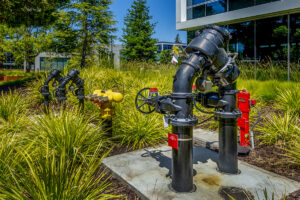
Backflow device testing is an essential service for commercial properties to ensure that it is working appropriately.
Backflow device testing is essential for maintaining a commercial property’s plumbing system and ensuring the safety of its water supply. Many business owners might not be familiar with this process, but it’s a critical safeguard against contamination. Backflow occurs when water flows in the opposite direction, potentially allowing pollutants and harmful substances to enter the clean water supply.
What Is Backflow and How Does It Happen?
Backflow occurs when there is a sudden change in water pressure within a plumbing system, causing water to flow in reverse. This can happen for various reasons, such as a broken water main, a significant increase in demand on the water supply (like during firefighting), or pump failures. When backflow happens, contaminated water from appliances, industrial processes, or external sources can flow back into the clean water supply, posing health risks.
The Role of Backflow Prevention Devices
To prevent this contamination, commercial properties are equipped with backflow prevention devices. These devices are designed to allow water to flow in only one direction, stopping any reverse flow from occurring. Depending on the complexity of your property’s plumbing system, you may have one of several types of backflow preventers, such as:
- Double check valves
- Reduced pressure zones (RPZ)
- Atmospheric vacuum breakers (AVB)
- Pressure vacuum breakers (PVB)
Each type of backflow prevention device operates differently, but the end goal is the same: preventing contaminated water from re-entering the main supply.
Why Is Backflow Device Testing Important?
Regular backflow device testing is crucial for ensuring that these systems are functioning correctly. Over time, wear and tear can cause these devices to malfunction or fail, leaving the property’s water supply vulnerable to contamination. Additionally, many jurisdictions require annual or biannual backflow testing to ensure compliance with local water quality standards.
Here are some key reasons why backflow testing is important:
- Public health protection: Backflow can introduce harmful substances such as chemicals, pesticides, or bacteria into the drinking water supply, potentially causing illness or environmental damage.
- Legal compliance: Most local and state regulations require commercial properties to test their backflow devices regularly. Failure to comply can result in fines, legal penalties, or the shutdown of your business until the issue is resolved.
- Protecting the property: Malfunctioning backflow devices can lead to extensive damage to your plumbing system, resulting in costly repairs or water damage to the property.
- Insurance requirements: Some insurance policies may require regular backflow testing to maintain coverage for water damage or liability claims.
What Happens During Backflow Device Testing?
Backflow testing must be performed by a certified professional who has the proper training and equipment to assess the device’s functionality. The process involves several steps:
- Visual inspection: The technician will inspect the backflow prevention device for signs of physical damage or wear and tear. If there are visible issues, these may need to be addressed before further testing.
- Shut-off procedure: The water supply will be temporarily shut off to test the device. This ensures that there’s no risk of contamination during the testing process.
- Device testing: Using specialized equipment, the technician applies different levels of pressure to the device to ensure that it allows water to flow in one direction and blocks any reverse flow.
- Report findings: After the test is complete, the technician will provide a detailed report outlining the condition of the device. If the device fails, they will recommend necessary repairs or replacement.
- Compliance reporting: Depending on local regulations, the test results may need to be submitted to your local water authority or health department.
What You Should Know About Backflow Device Maintenance
In addition to annual testing, maintaining your backflow prevention device is crucial for its long-term functionality. Commercial property owners should be proactive in ensuring the following:
- Regular inspections: Even though backflow devices are tested annually, periodic visual inspections can help catch potential issues early.
- Repairs and replacement: If a backflow device fails a test, it needs to be repaired or replaced immediately. Delaying these repairs can lead to health risks and legal penalties.
- Documenting your tests: Keep detailed records of all backflow device tests, repairs, and inspections. This documentation is essential for compliance with local regulations and insurance purposes.
Call Mahon Plumbing Today
If you still have more questions regarding your plumbing, we here at Mahon Plumbing are here to help. We have been serving the wider Baltimore area since 1994, so we have 25 years of experience to back up our fantastic service! Call us at our Baltimore location at 410-766-8566 or our Pasadena location at 410-636-7944. Be sure to keep up with us on social media by following us on Facebook or Twitter.
